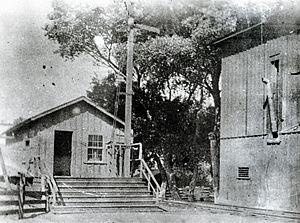Lang Southern Pacific Station facts for kids
Quick facts for kids Lang Southern Pacific Station |
|
|---|---|

Lang Southern Pacific Station in 1906, the second depot
|
|
| Location | Canyon Country, Santa Clarita, California |
| Built | 1876 |
| Designated | May 22, 1957 |
| Reference no. | 590 |
| Lua error in Module:Location_map at line 420: attempt to index field 'wikibase' (a nil value). | |
Lang Station was an important railway station in Canyon Country, Santa Clarita, California. It was a key spot for the Southern Pacific railroad company. On September 5, 1876, a special event happened here. The first railway line connecting Los Angeles to San Francisco was completed at this very spot! Today, the Lang Southern Pacific Station is recognized as a California Historical Landmark (No. 590).
Contents
History of Lang Station
The Golden Spike Ceremony
On September 5, 1876, Charles Crocker hammered a special "golden spike" into a railroad tie at Lang Station. Crocker was the president of the Southern Pacific Transportation Company. This golden spike was a ceremonial spike, not made of real gold. It celebrated the completion of the San Joaquin Valley rail line. This new line finally connected Los Angeles with San Francisco and the main Transcontinental Railroad.
The Station Buildings
Over the years, four different wooden buildings served as the Lang train station. The first one was built in 1873. A new station replaced it in January 1888. However, this second station burned down in a fire on August 14, 1888. The third station also caught fire and burned down on October 5, 1906. The fourth and final station building was taken down in 1969. Even though it was a California Historic Landmark, it could not be saved from being removed. The station was named after John Lang. In 1871, Lang built a hotel nearby to serve visitors to the local Sulphur Springs.
Connecting the Country
The First Transcontinental Railroad was finished in 1869. This railroad connected the East Coast of the United States with San Francisco. However, it did not reach Los Angeles directly. The Transcontinental Railroad was completed at Promontory Point, Utah, in May 1869. Two teams worked on it: one from west to east and one from east to west. Charles Crocker was part of the western team. This western crew was built by the Central Pacific Railroad. The Central Pacific Railroad was managed by Collis Potter Huntington, Mark Hopkins Jr., Leland Stanford, and Charles Crocker. The Southern Pacific Railroad was later formed when the Central Pacific bought smaller railroad companies in California.
Railroad Expansion
In 1870, the Southern Pacific Railroad bought the San Francisco and San Jose Railroad from Henry Mayo Newhall. Newhall was later appointed to the Board of Directors of the Southern Pacific Railroad. Henry Newhall then helped create the city of Newhall. He bought part of Rancho San Francisco in 1875 to form this new city.
In 1887, the Southern Pacific Railroad began to expand even more. They built a new line through the Santa Clarita Valley to Santa Barbara. Along this new line, a new town called Saugus was built. The town was named after Saugus, Massachusetts, where Henry Newhall was born. The Southern Pacific built two train stations to serve the valley: the Newhall train station and the Saugus train station. The Newhall train station is no longer there. The Saugus train station was used until the last passenger train service ended in April 1971. Freight train service stopped in 1979. The Saugus train station officially closed on November 15, 1978. Because many people wanted to save it, the Saugus Train Station was moved to a new spot on June 24, 1980. Today, the Saugus train station is next to the William S. Hart Ranch and Museum in Newhall's Heritage Junction.
The old Southern Pacific rail line is still in use today. It is now part of the Metrolink Antelope Valley Line. This line has new stations like the Newhall station, Via Princessa station, Vincent Grade/Acton station, and Santa Clarita station.
Historical Marker
There is a special marker at the site of Lang Station. It is next to the train tracks. The marker reads:
- NO. 590 LANG SOUTHERN PACIFIC STATION - On September 5, 1876, Charles Crocker, President of the Southern Pacific Company, drove a gold spike here to complete his company's San Joaquin Valley line, the first rail connection of Los Angeles with San Francisco and transcontinental lines."
- The marker is located on Lang Station Road, where the road crosses the train track. It is off California State Route 14 and Soledad Canyon Road, near the Santa Clara River.


